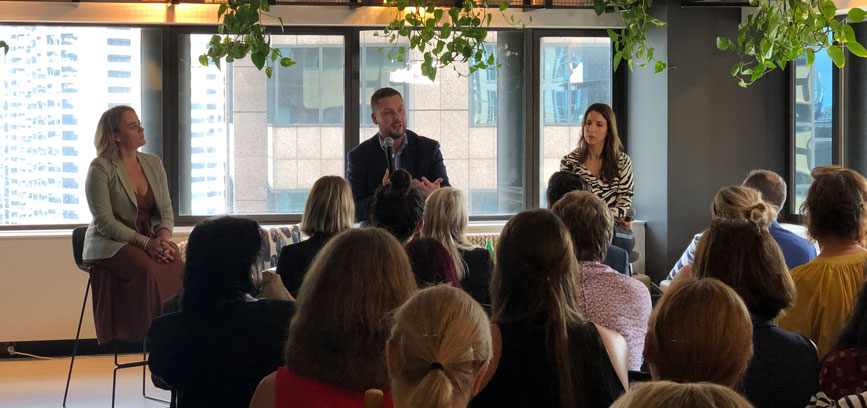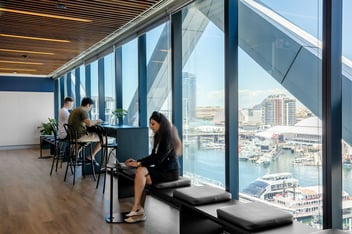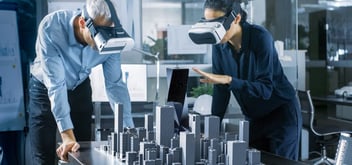Workplace wellness is not only important for moral and ethical reasons, but financial reasons, too. In fact, a recent study found that every year, absenteeism costs the Australian economy an estimated $44 billion, while presenteeism (working at a reduced capacity) more than $35 billion.
So what are organisations doing to promote workplace wellness?
At our recent lunch and learn, we covered how organisations can produce the best bottom-line results through workplace wellness initiatives with our panel of experts:
- Dr Debra Villar, Director at Complete Corporate Wellness, a company that provides health and wellness programs for the corporate sector.
- Jack Noonan, Vice President Australia & New Zealand at International WELL Building Institute, which is leading the movement to promote health and wellness in buildings and communities everywhere through their cutting-edge WELL Building Standard™.
- Annelie Xenofontos, Senior Workplace Strategist at Axiom Workplaces, who leads the strategic thinking process that creates intelligent workplace design outcomes for our clients.
Here’s what they had to say about wellness trends they were noticing in Australian workplaces.
How are buildings changing to support workplace wellness initiatives?
Circadian lighting
Noonan explains that 20 years ago, all offices were using bright, fluorescent lighting that didn’t change throughout the day, which led to a disruption of sleep at night.
This is why today, more organisations are using circadian lighting – that is, lighting that mimics your daily cycle. Lighting will mimic daylight midday, and become warmer in the afternoon as you finish work.
Most results are qualitative instead of quantitative, with organisations saying that staff are requesting circadian table lamps and more likely to use meeting rooms with circadian lighting.
End of trip facilities
Noonan explains that Australia is well ahead of the United States in terms of our end of trip facilities, simply because large developers and workplaces are willing to make end of trip facilities spacious enough for tenants to share and enjoy.
For example, the recently opened International Towers in Barangaroo boast the largest bike parking facility in the southern hemisphere, with room for over 1000 bicycles and more than 100 showers. This encourages cycling to work which not only reaps health benefits, but also environmental benefits.
How are organisations supporting nutrition?
Villar explains that some businesses go to the extreme by providing gourmet meals, which are pre-planned by a head chef – but not all businesses can afford this, so it’s more about providing healthy alternatives. If unhealthy snacks are available, you can place them on the bottom-shelf so that they’re not prominently promoted.
According to Noonan, 50% of food options should be fresh fruit and vegetables – or at the very least, organisations should provide two options of fruit and two options of vegetables. This is to ensure that making the healthier choice is the easier choice and that staff have options available.
Additionally, by simply providing inviting spaces for people to come together and eat, organisations are encouraging a balanced diet, as people tend to eat healthier when they eat together. A requirement of the WELL Building Standard is that there is space for at least 25% of employees to have lunch at any point in time. While it’s certainly an investment in real estate (as you’re sacrificing space that could be used as work stations), it’s an important factor for workplace wellness.
How are organisations supporting mental health?
According to Villar, 1 in 4 people in the world have a mental disorder but no one wants to admit it. Stigma prevents people with a known disorder to seek help from health professionals – even if treatment is available.
Movements like R U OK? Day help in supporting those who are struggling by inspiring people to start talking about mental health. Companies and other organisations are also doing their part in supporting mental health and creating a healthy workplace. Villar highlighted that a healthy company not only focuses on the health of an individual but on the health of the whole organisation.
A focus on taking action
Organisations are starting to go beyond the simple measurement of chronic diseases by implementing health programs that build fun and engaging workplaces.
Previous programs comprised mainly of checklists, and centred mostly on the measurement of data. Managers would tick boxes, analyse the data and conclude, for instance, that 10% of employees have a risk of diabetes. But these numbers have no value if they don’t help solve actual health issues and affect change.
Australian companies still conduct biometric testing for glucose and other health checks – but are beginning to move away from that and focus on fun and engaging activities like workplace challenges, team projects and treatment days.
Villar also mentioned that there are cost-effective ways to encourage employees to take the stairs, simply by making them more appealing. For example, you could allow people to draw artwork and write quotes along the wall near the staircase.
These activities actually make a difference in people’s health, instead of simply drawing conclusions around the percentage of staff that have chronic diseases.
Support the mental health of managers
More organisations are recognising the importance of supporting managers with the tools they need to support their own mental health, so that they can, in turn, support the mental health of their teams.
“It’s all well and good to provide education to staff around mental health, but if you’re not providing dedicated support to their managers so that they can walk the talk and inspire staff, then you’re missing an important point,” explains Villar.
Leaders need to have the necessary tools to deal with mental health issues, as they can be quite confronting.
Villar and her team provide a mental health first aid course for organisations – helping people recognise signs of mental disorders, what to do, and how to deal with those signs.
Focus on office design
Xenofontos explains that organisations are using office design to positively impact mental health. One example is through the use of open-plan offices.
She mentioned the experience of a person who worked in a law firm that had partitioned offices for every lawyer. Because of this, no one in the office noticed when one particular staff member was having a difficult time dealing with his wife’s illness and suffering from a mental health crisis. The fact that staff were separated by their own cubicles meant that he could come to the office before anyone arrived, and leave the office after everyone left – without anyone noticing.
Xenofontos stressed that if it was an open plan office, other staff would more likely notice the decline in his wellbeing, and offer some support. This is why it’s important to consider how office design can impact employee health and wellness.
A workplace design partner can help you build a healthier office for your managers and staff. To help you find the perfect one for your business, check out our free ebook, How to Choose the Right Workplace Design Partner.
Or if you’d like some free advice, why not meet with us and get a comprehensive design assessment and execution plan, obligation-free?







